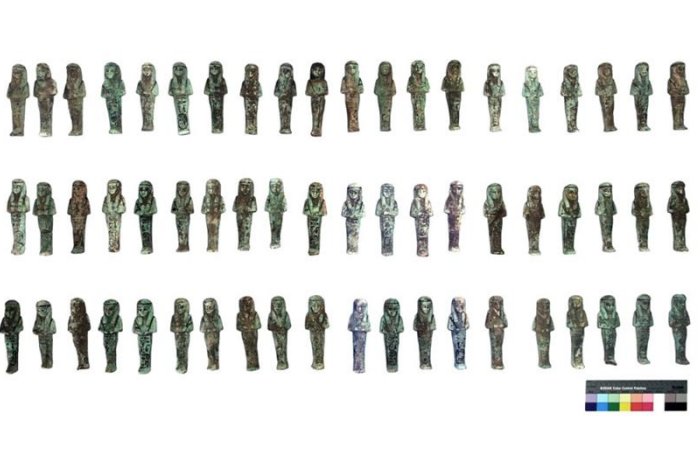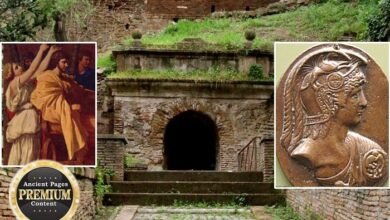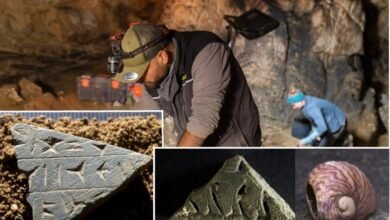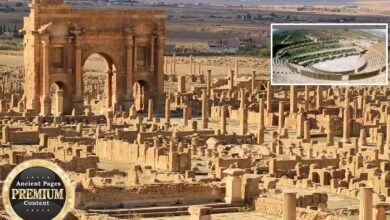Mystery Of Pharaoh Shoshenq III’s Sarcophagus Deepens: Unknown Ancient Egyptian Inscriptions And 225 Royal Ushabti Figurines Discovered In Tanis
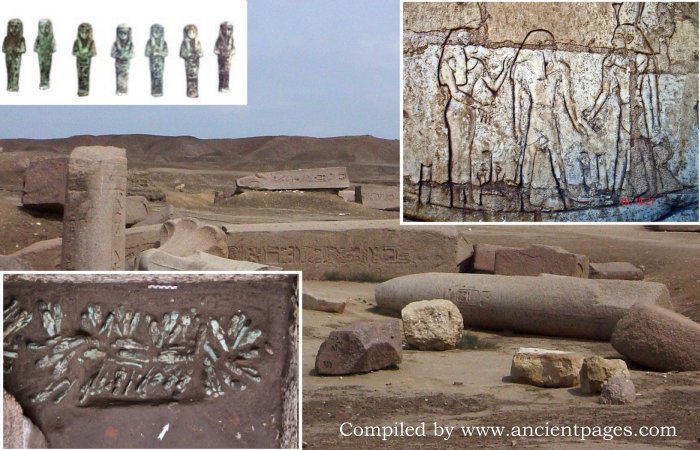
Jan Bartek – AncientPages.com – Shoshenq III was a Pharaoh of ancient Egypt who ruled during the Third Intermediate Period, specifically during the 22nd Dynasty. His reign is generally dated to around 837 BCE to 798 BCE, though there is scholarly debate over the exact years. Shoshenq III came to power under uncertain circumstances, likely following the death of his grandfather, Osorkon II—a transition that may have sparked a succession crisis.
Shoshenq III, standing on the boat “msktt”, the boat of the night, with the god Atum. From his tomb in Tanis. Credit: Juan R. Lazaro – CC BY 2.0
For many years, it has been believed that Shoshenq III was buried at San el-Hagar, the royal necropolis in ancient Tanis. However, recent archaeological discoveries have introduced new questions about his final resting place. During excavations at San el-Hagar, a French archaeological team led by Frédéric Payraudeau from Sorbonne University uncovered 225 ushabti figurines belonging to King Shoshenq III. This discovery has been described as the most significant find in Tanis since 1946.
Ushabti were servant figurines placed in tombs as part of ancient Egyptian religious practices. These small, mummy-shaped figures, often depicted with crossed arms on the chest, were intended to serve their deceased owners in the afterlife. Their widespread use reflected the belief that ushabti would perform any required labor on behalf of the deceased, thereby freeing them from work in the next world.
225 royal ushabti figurines were unearthed at the Tanis archaeological site in the Nile Delta. Credit: Ministry of Tourism and Antiquities
The recently unearthed Ushabti figurines were found in excellent condition within layers of silt in the northern chamber of King Osorkon II’s tomb, near an undecorated granite sarcophagus whose ownership had long been uncertain. The site is located in Egypt’s Husseiniya district, within Sharqiya Governorate—an area historically situated along the Tanitic branch of the Nile River.
Ancient Mystery Of Pharaoh Shoshenq III’s Burial
For decades, archaeologists have debated who originally occupied this sarcophagus. The recent association between these ushabtis and the sarcophagus now provides strong evidence that it may belong to Shoshenq III, one of the most influential rulers of his dynasty and noted for his architectural contributions in Tanis. This connection suggests either that Shoshenq III’s burial items were moved into this chamber for protection or that he was interred within Osorkon II’s tomb itself. Another possibility is that he placed another family member in this sarcophagus while including his own funerary figurines.
Credit: Ministry of Tourism and Antiquities
Mohamed Ismail Khaled, Secretary-General of the Supreme Council of Antiquities (SCA), described the recent discovery at Tanis as a “landmark moment for Tanis excavations”. He noted that this is the most important find at the site since the mid-20th century. Khaled highlighted that identifying the owner of the newly discovered sarcophagus could provide valuable insights into royal burial practices during Egypt’s Third Intermediate Period. Specifically, it may help determine whether Shoshenq III was interred in Osorkon II’s tomb or if his funerary items were moved there later for safekeeping.
Archaeologists examine the ancient tomb at San el-Hagar. Credit: Ministry of Tourism and Antiquities
This discovery underscores Tanis’s continued archaeological importance and potential. Khaled emphasized that “the site still holds many secrets,” pointing to a strong need for further excavation and conservation work at this historically significant royal center.
Previously Unknown Ancient Inscriptions May Hold Vital Clues
In addition, the archaeological team found new inscriptions within the same chamber. Mohamed Abdel-Badie, Head of Egypt’s Antiquities Sector, explained that these inscriptions will aid researchers in better understanding how royal tombs were utilized and modified during this period.
Dr. Hesham Hussein, head of the Central Department of Lower Egypt Antiquities, noted that this discovery is part of a larger conservation initiative. The French archaeological mission, active in Tanis since 1929, is collaborating with the Supreme Council of Antiquities on a comprehensive protection project. This includes installing a modern shelter over the royal tombs and conducting extensive desalination and architectural cleaning.
See also: More Archaeology News
According to Dr. Payraudeau, the next phase will focus on an in-depth study of newly discovered inscriptions and continued cleaning of the tomb’s northern chamber, which may provide further insights into Shoshenq III’s burial circumstances. He explained that it remains unclear whether King Shoshenq III was buried directly within Osorkon II’s tomb or whether his funerary equipment was moved there later.
Sarcophagus of Osorkon II. from the Royal Cemetery, San el-Hagar (Tanis), Egypt. Credit: Roland Unger – CC BY-SA 3.0
As Tanis gains renewed attention through these findings, they significantly contribute to our understanding of one of Egypt’s most historically significant archaeological sites and continue to shed light on royal burial practices and political dynamics during Egypt’s Third Intermediate Period.
Source: Ministry of Tourism and Antiquities
Written by Jan Bartek – AncientPages.com Staff Writer



